Sooner or later in your chess games, you’re going to have to learn how to win with a limited number of pieces. It may even be down to you having 2 pieces (for the sake of this blog a King and a Rook) and your opponent is left with only 1 piece (a King).
There is a 50-move rule in chess… that if each opponent makes 50 moves and has not taken another piece in that time, the game is a draw. So, if you’re down to a King and Rook, and your opponent has just a King, you have only 50 moves left in which you have to checkmate! The pressure is on!
It really does not matter where the pieces start, you’ve got only 50 moves to win once it’s down to just a King+Rook VS King. So, for the sake of argument, I’ve placed everything near the center of the board… this will make winning a little harder and more time consuming, but it can be done. So, here’s our starting position, with white to move:
There’s clearly no way to get a checkmate while black’s king is out in the open and has so much room to run… so we need to force him to an edge (preferably a corner). How do we do that?
Imagine the Rook as a post for an invisible fence. The black king can never cross that fence (IE any of the squares the rook controls… which in our starting position would be any of the squares along the D file or any of the 4th rank). If you can make the the king more and more confined, you will win.
BUT REMEMBER, black has 3 goals at this point. Goal 1) try to last 50 moves to make the game a draw. Goal 2) try to take the rook, so that only the 2 Kings remain, making the game a draw. Goal 3) get put into a stalemate for a draw.
As white, you must stop this at all costs. You’ll be using your Rook to make the invisible fence smaller and smaller and your king to (at first) protect the Rook and then later to cut off a square from black’s king to make checkmate possible.
Let’s take another look at the starting position:
We need to make Black’s possible squares smaller, but we can’t just yet because if we move the Rook right now, we’ll be giving the black king MORE space… so first let’s move our King to keep the Rook guarded, and we’ll make the fence smaller on the next move. Let’s go with Kc4. My chess computer then does Ke6.
Now we can make the “fenced area” smaller with Rd5. Then black moves his King (my computer did Kf6).
Now it gets SLIGHTLY tricky, but don’t worry. The next move needs to be a King move (we don’t want to move the Rook because then we’ll either a) put it in danger or b) give black more freedom. We also want to keep our King on the opposite side of the “fence” so that black can never use our King as a shield to get past the fence. So we’re going to do Kd4. Black does Ke6 and we do Ke5 to force black’s King further in the corner.
It doesn’t matter what black does. Our goal remains the same: give black less room to move and keep the rook safe until the mate happens. In the end, we get to this position (with black to move) just a few moves before the mate:
Black’s only 2 squares left are h8 and h7. He HAS to go to h7 now. We want to keep him in this micro-sized jail cell so we’ll walk our King around the back with the following:
1) Kg5…Kh8. 2) Kf6…Kh7. 3) Kf7…Kh8
See how we’ve kept black trapped in and just kept our rook safe while we walked around to a better position for our own King? Now comes the winning move of Rh6#:
Set it up and try it yourself. Let someone else put the 3 pieces anywhere on the board for you and see if you can figure it out (and remember to keep track of your moves… remember, if you make more than 50, it’s a draw…). But the plan is always going to be the same: force your opponent’s King into a tighter and tighter space.

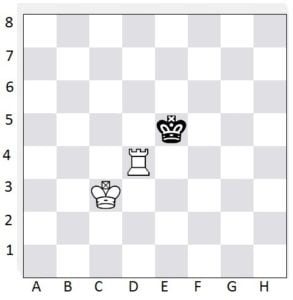
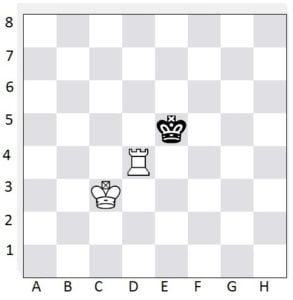
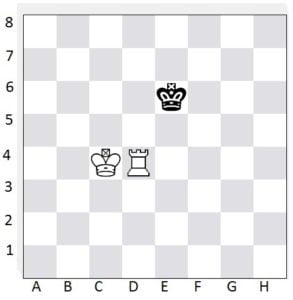
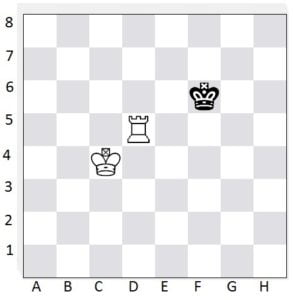
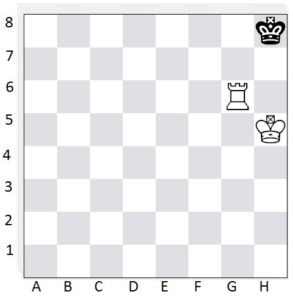
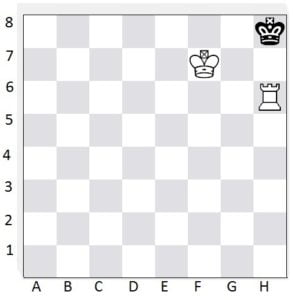
For white king and rook versus the black king, what should be the objective regarding accuracy? For example, if engine says mate in 12 and I mate in 16 my accuracy is 75%, correct? What is a realistic accuracy for different ELO ratings, notwithstanding the 50 move rule?